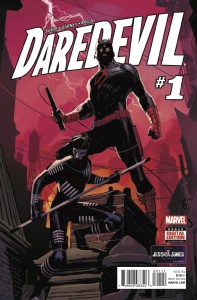 Daredevil #1 — Writer: Charles Soule; Art: Ron Garney; Colors: Matt Milla
Daredevil #1 — Writer: Charles Soule; Art: Ron Garney; Colors: Matt Milla
The Totally Awesome Hulk #1 — Writer: Greg Pak; Art: Frank Cho; Colors: Sonia Oback
Red Wolf #1 — Writer: Nathan Edmondson; Pencils: Dalibor Talajic; Inks: Jose Marzan, Jr.; Colors: Miroslav Mrva
All-New X-Men #1 — Writer: Dennis Hopeless; Pencils: Mark Bagley; Inks: Andrew Hennessy; Colors: Nolan Woodard
 Guardians of Infinity #1 — Writer: Dan Abnett; Pencils: Carlo Barberi; Inks: Walden Wong; Colors: Israel Silva
Guardians of Infinity #1 — Writer: Dan Abnett; Pencils: Carlo Barberi; Inks: Walden Wong; Colors: Israel Silva
All-New Inhumans #1 — Writers: James Asmus and Charles Soule; Art: Stefano Caselli; Colors: Andres Mossa
Spidey #1 — Writer: Robbie Thompson; Art: Nick Bradshaw; Colors: Jim Campbell
Seven new Marvel first issues this week — and, unlike many of the previous ones, some of these are real reboots, with massive changes for their characters. Daredevil, for example, sees Matt Murdock back in New York City, with Soule and Garney using a dark, shadowy style instead of the brightly-colored, swashbuckling Waid/Samnee one of the last volume. Perhaps most 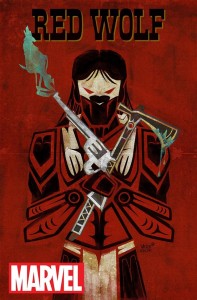 startling, instead of everyone knowing that Daredevil is Matt Murdock (a plot twist that’s been around for over a decade now, and driven a large part of the storylines during that time), now one knows but his partner, Foggy Nelson. There’s a brief reference to it happening, but no explanation as to how, but of course the real-life reason is that now the comic looks like the hit TV show. The result isn’t a bad book, just a very different one, and one that might upset some longtime readers — although it really shouldn’t; it’s good for what it’s trying to do. The Totally Awesome Hulk features similar big changes, and runs a similar risk of alienating readers, since in this new version the gamma-irradiated big guy is no longer Bruce Banner (there are a couple of flashback pages getting him out of commission), but
startling, instead of everyone knowing that Daredevil is Matt Murdock (a plot twist that’s been around for over a decade now, and driven a large part of the storylines during that time), now one knows but his partner, Foggy Nelson. There’s a brief reference to it happening, but no explanation as to how, but of course the real-life reason is that now the comic looks like the hit TV show. The result isn’t a bad book, just a very different one, and one that might upset some longtime readers — although it really shouldn’t; it’s good for what it’s trying to do. The Totally Awesome Hulk features similar big changes, and runs a similar risk of alienating readers, since in this new version the gamma-irradiated big guy is no longer Bruce Banner (there are a couple of flashback pages getting him out of commission), but  the brilliant, smartass teenager Amadeus Cho. It helps that all of this is written by Greg Pak (a very longtime Hulk writer, who penned the “Planet Hulk” storyline many years ago, and who’s used Cho quite a bit) and drawn by Frank “no relation to Amadeus” Cho, an accomplished artist who’s quite good at action scenes and the kind of exaggerated anatomy that works well in superhero books. Like Superior Spider-Man, another comic that sounded terrible as a concept and turned out to be decent, this has a good shot. Will Cho bite off more than he can chew? Will the Hulk’s dark side overcome his naturally-sunny disposition? Let’s see how many readers are interested enough to find out. Meanwhile, Red Wolf has a different problem, with its obscure and unpowered Native American lead, but it’s coming off of that title character’s starring role in the
the brilliant, smartass teenager Amadeus Cho. It helps that all of this is written by Greg Pak (a very longtime Hulk writer, who penned the “Planet Hulk” storyline many years ago, and who’s used Cho quite a bit) and drawn by Frank “no relation to Amadeus” Cho, an accomplished artist who’s quite good at action scenes and the kind of exaggerated anatomy that works well in superhero books. Like Superior Spider-Man, another comic that sounded terrible as a concept and turned out to be decent, this has a good shot. Will Cho bite off more than he can chew? Will the Hulk’s dark side overcome his naturally-sunny disposition? Let’s see how many readers are interested enough to find out. Meanwhile, Red Wolf has a different problem, with its obscure and unpowered Native American lead, but it’s coming off of that title character’s starring role in the  Secret Wars spin-off 1872, and this first issue picks up from the end of that book, as the old-West town of Timely, in an alternate universe where Marvel characters like Tony Stark and Wilson Fisk lived in that time period, has him as its new sheriff. There’s a lot of predictable bitching by the townspeople (with the word “injun” coming up a lot), pretty standard action around some solid art by Talajic (European artists always love tackling the romance and novelty of the American West), and a twist at the end that’s either intriguing or disappointing, depending on whether you’ve liked the Elseworlds-style setting up to now. Will the book catch on? It’s probably a long shot, but this first issue isn’t s total loss, so it’s got another couple of months to make its case. All-New X-Men has the advantage of a built-in fan base, and while the writer has changed, it still picks up from the end of Brian Michael Bendis’s long run: the ’60s teen versions of
Secret Wars spin-off 1872, and this first issue picks up from the end of that book, as the old-West town of Timely, in an alternate universe where Marvel characters like Tony Stark and Wilson Fisk lived in that time period, has him as its new sheriff. There’s a lot of predictable bitching by the townspeople (with the word “injun” coming up a lot), pretty standard action around some solid art by Talajic (European artists always love tackling the romance and novelty of the American West), and a twist at the end that’s either intriguing or disappointing, depending on whether you’ve liked the Elseworlds-style setting up to now. Will the book catch on? It’s probably a long shot, but this first issue isn’t s total loss, so it’s got another couple of months to make its case. All-New X-Men has the advantage of a built-in fan base, and while the writer has changed, it still picks up from the end of Brian Michael Bendis’s long run: the ’60s teen versions of 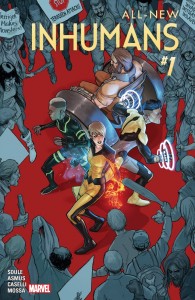 Cyclops, Beast, Iceman and Angel (Jean Grey’s over in Extraordinary X-Men), joined by Laura, the X-23 Wolverine clone; Kid Apocalypse from Wolverine and the X-Men; and Indie Okonkwo (whose powers I can’t remember, but since she gets nothing to do in this issue, I suppose it doesn’t matter…). Mark Bagley always delivers approachable, good-looking art, and there’s enough action to keep him busy here; fans of the previous series should be perfectly happy with this one. Guardians of Infinity is a kind of Guardians of the Galaxy mash-up, with the current version of the team (including The Thing) investigating a massive structure/spaceship, and running into the original 3000 AD version (the ship being not only huge but extending into different time periods and dimensions), and teaming up to battle hostile aliens, leading to yet another GOTG version at the end. Abnett’s an old hand at these characters, and a clever writer, so it’s good as Guardians books go; it’s not listed as one, but I’d think it would work a lot better as a stand-alone
Cyclops, Beast, Iceman and Angel (Jean Grey’s over in Extraordinary X-Men), joined by Laura, the X-23 Wolverine clone; Kid Apocalypse from Wolverine and the X-Men; and Indie Okonkwo (whose powers I can’t remember, but since she gets nothing to do in this issue, I suppose it doesn’t matter…). Mark Bagley always delivers approachable, good-looking art, and there’s enough action to keep him busy here; fans of the previous series should be perfectly happy with this one. Guardians of Infinity is a kind of Guardians of the Galaxy mash-up, with the current version of the team (including The Thing) investigating a massive structure/spaceship, and running into the original 3000 AD version (the ship being not only huge but extending into different time periods and dimensions), and teaming up to battle hostile aliens, leading to yet another GOTG version at the end. Abnett’s an old hand at these characters, and a clever writer, so it’s good as Guardians books go; it’s not listed as one, but I’d think it would work a lot better as a stand-alone  mini-series than an ongoing title, just because the concept would be hard to sustain for very long. That leaves All-New Inhumans, yet another title starring those characters; this one has the advantage of Crystal as one of its leads, with her visually-attractive elemental powers making the action scenes clear and energetic (so many of the Inhumans have weird energy powers, which end up translating as squiggly lines shooting at the bad guys), although I have to admit the whole terrigen-mist/nuHuman thing lost my interest months ago. That leaves Spidey, whose hook is that it’s one of those past-centered Peter-Parker-in-high-school books (he meets Gwen Stacy in this issue), with Thompson, who’s already shown he can do light-hearted Spider-centric books with Spider-Gwen, handling the writing; if you’re old-school enough to like this era of Parker’s career, it’s a decent version of it, with Norman Osborne, Flash Thompson and Doc Ock all making appearances, and acting just about as you’d think they would.
mini-series than an ongoing title, just because the concept would be hard to sustain for very long. That leaves All-New Inhumans, yet another title starring those characters; this one has the advantage of Crystal as one of its leads, with her visually-attractive elemental powers making the action scenes clear and energetic (so many of the Inhumans have weird energy powers, which end up translating as squiggly lines shooting at the bad guys), although I have to admit the whole terrigen-mist/nuHuman thing lost my interest months ago. That leaves Spidey, whose hook is that it’s one of those past-centered Peter-Parker-in-high-school books (he meets Gwen Stacy in this issue), with Thompson, who’s already shown he can do light-hearted Spider-centric books with Spider-Gwen, handling the writing; if you’re old-school enough to like this era of Parker’s career, it’s a decent version of it, with Norman Osborne, Flash Thompson and Doc Ock all making appearances, and acting just about as you’d think they would.
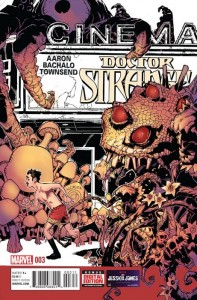 Doctor Strange #3 — Writer: Jason Aaron; Pencils/Colors: Chris Bachalo; Inks: Tim Townsend, Al Vey and Mark Irwin
Doctor Strange #3 — Writer: Jason Aaron; Pencils/Colors: Chris Bachalo; Inks: Tim Townsend, Al Vey and Mark Irwin
Extraordinary X-Men #2 — Writer: Jeff Lemire; Pencils: Humberto Ramos; Inks: Victor Olazaba; Colors: Edgar Delgado
Avengers #2 — Writer: Mark Waid; Art: Adam Kubert;  Colors: Sonia Oback
Colors: Sonia Oback
The Vision #2 — Writer: Tom King; Art: Gabriel Hernandez Walta; Colors: Jordie Bellaire
Invincible Iron Man #4 — Writer: Brian Michael Bendis; Art: David Marquez; Colors: Justin Ponsor
 The other Marvel titles — Doctor Strange continues to be the best, with Aaron giving Baachalo lots of other-dimensional creatures to draw, and crafting a plot involving a magical crisis-of-the-month in each issue, with a subplot involving a race of anti-magician Puritans who want to kill all the sorcerers across the multiverse, and now have Strange in their sites. Between the easy-to-like characterization and the wonderful art, this is an obvious title to recommend. Extraordinary X-Men has a better second issue than its first, because the meeting between teen Jean
The other Marvel titles — Doctor Strange continues to be the best, with Aaron giving Baachalo lots of other-dimensional creatures to draw, and crafting a plot involving a magical crisis-of-the-month in each issue, with a subplot involving a race of anti-magician Puritans who want to kill all the sorcerers across the multiverse, and now have Strange in their sites. Between the easy-to-like characterization and the wonderful art, this is an obvious title to recommend. Extraordinary X-Men has a better second issue than its first, because the meeting between teen Jean  Grey and old-guy Wolverine has a lot of built-in interest (both characters have a lot of history with each other, but not with these two particular versions of themselves; if that sentence confuses you, you need to read more comics…), and because Ramos has such a fun, unique style. Avengers #2 benefits from a good creative team, too, as Adam Kubert and the always-dependable Mark Waid continue to chronicle the origin of this particular version of the team, while everyone chases after an alien overlord who’s trying to put a MacGuffinny super-weapon together; it’s a classic version of a Marvel-
Grey and old-guy Wolverine has a lot of built-in interest (both characters have a lot of history with each other, but not with these two particular versions of themselves; if that sentence confuses you, you need to read more comics…), and because Ramos has such a fun, unique style. Avengers #2 benefits from a good creative team, too, as Adam Kubert and the always-dependable Mark Waid continue to chronicle the origin of this particular version of the team, while everyone chases after an alien overlord who’s trying to put a MacGuffinny super-weapon together; it’s a classic version of a Marvel- style superhero book. The Vision is anything but; King offers a synthezoid who’s created a wife, two kids and a suburban lifestyle for himself, but it’s peeling apart at the edges, in odd and spooky ways; he and Walta are creating a surprisingly-creepy and unusual little comic here, and it’s nice to see them taking some chances with it. Invincible Iron Man is a lot more standard, with Stark, Madame Masque and a maskless Dr. Doom in the cast, and a Spider-Man-less Mary Jane Watson coming on board this issue; it’s standard Bendis professionalism, with clever little scenes, enough action and humor to keep our interest, and a recognizable and fun version of the character on display.
style superhero book. The Vision is anything but; King offers a synthezoid who’s created a wife, two kids and a suburban lifestyle for himself, but it’s peeling apart at the edges, in odd and spooky ways; he and Walta are creating a surprisingly-creepy and unusual little comic here, and it’s nice to see them taking some chances with it. Invincible Iron Man is a lot more standard, with Stark, Madame Masque and a maskless Dr. Doom in the cast, and a Spider-Man-less Mary Jane Watson coming on board this issue; it’s standard Bendis professionalism, with clever little scenes, enough action and humor to keep our interest, and a recognizable and fun version of the character on display.
 Robin War #1 (of 2) — Writer: Tom King; Breakdowns: Rob Haynes; Art: Khary Randolph; Alain Mauricet; Jorge Corona; Andres Guinaldo and Walden Wong; Colors: Emilio Lopez, Chris Sotomayor, Gabe Eltaeb and Sandra Molina
Robin War #1 (of 2) — Writer: Tom King; Breakdowns: Rob Haynes; Art: Khary Randolph; Alain Mauricet; Jorge Corona; Andres Guinaldo and Walden Wong; Colors: Emilio Lopez, Chris Sotomayor, Gabe Eltaeb and Sandra Molina
Harley’s Little Black Book #1 — Writers: Jimmy Palmiotti and Amanda Connor; Art: Amanda Connor with John Timms; Colors: Paul Mounts with Hi-Fi
All-Star Section Eight #6 (of 6) — Writer: Garth Ennis; Art: John McCrea; Colors: John Kalisz
 The Sheriff of Babylon #1 (of 8) — Writer: Tom King; Art/Colors: Mitch Gerads
The Sheriff of Babylon #1 (of 8) — Writer: Tom King; Art/Colors: Mitch Gerads
The DC stuff that stood out — Robin War is one of those bookend series that sets up a confrontation between the various characters from Grayson; We Are Robin; Robin, Son of Batman and Gotham Academy (no, I don’t know how that last one fits, either, but it’s a quirky, cool little title, so anything that draws more attention to it is fine with me), will run through those books, and then conclude with a second issue. It involves one of the teen We Are Robin characters interfering in a robbery and accidentally leading to the death of a policeman, after which Gotham  City introduces a series of “Robin Laws” that make it a crime to have anything to do with imitating, dressing like or calling yourself “Robin”; if that seems stupid, that’s because it’s actually being orchestrated by the Court of Owls (not a spoiler, since look at the book’s cover), and if you’re a Bat-fan then reading about all the sidekick characters fighting the Owls should sound pretty cool (although having a total of ten people involved with the art and coloring of this issue is not exactly a good sign…). Harley’s Little Black Book is a Harley Quinn team-up book, with this first issue starring Wonder Woman (whom it turns out Harley has a lifelong-crush on); its selling point is not only the writing, by the
City introduces a series of “Robin Laws” that make it a crime to have anything to do with imitating, dressing like or calling yourself “Robin”; if that seems stupid, that’s because it’s actually being orchestrated by the Court of Owls (not a spoiler, since look at the book’s cover), and if you’re a Bat-fan then reading about all the sidekick characters fighting the Owls should sound pretty cool (although having a total of ten people involved with the art and coloring of this issue is not exactly a good sign…). Harley’s Little Black Book is a Harley Quinn team-up book, with this first issue starring Wonder Woman (whom it turns out Harley has a lifelong-crush on); its selling point is not only the writing, by the 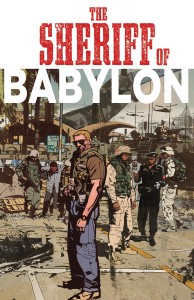 standard HQ team of Palmiotti and Connor, but the fact that Connor actually does the art too, and watching her draw both WW and HQ is reason enough to buy the book. All-Star Section Eight concludes its run with a surprisingly-poignant look at the nature of reality in the DC universe (mixed in with all the cruel jokes and filth, though, this being a Garth Ennis comic), and should appeal to readers who’ve suspected all the company’s continuity the last decade or so was crafted by some drunk in some alley somewhere. That leaves the Vertigo offering, Sheriff of Babylon, a gritty, violent and well-crafted tale about an American in Baghdad in 2004; it’s King’s third book this week, along with The Vision and Robin War, and shows him to be a versatile newcomer who’s good at delivering unexpected twists and interesting stories in three very different genres.
standard HQ team of Palmiotti and Connor, but the fact that Connor actually does the art too, and watching her draw both WW and HQ is reason enough to buy the book. All-Star Section Eight concludes its run with a surprisingly-poignant look at the nature of reality in the DC universe (mixed in with all the cruel jokes and filth, though, this being a Garth Ennis comic), and should appeal to readers who’ve suspected all the company’s continuity the last decade or so was crafted by some drunk in some alley somewhere. That leaves the Vertigo offering, Sheriff of Babylon, a gritty, violent and well-crafted tale about an American in Baghdad in 2004; it’s King’s third book this week, along with The Vision and Robin War, and shows him to be a versatile newcomer who’s good at delivering unexpected twists and interesting stories in three very different genres.
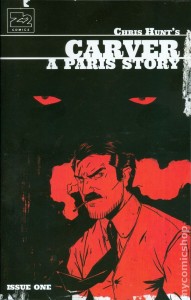 Carver: A Paris Story #1 — Creator: Chris Hunt; Back-up story: Paul Pope
Carver: A Paris Story #1 — Creator: Chris Hunt; Back-up story: Paul Pope
Seduction of the Innocent #1 — Writer: Ande Parks; Art: Esteve Polls; Colors: Salvatore Aiala Studios
Jim Henson’s The Storyteller: Dragons #1 (of 4) — 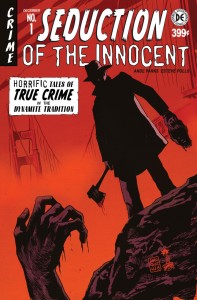 Story/Art/Colors: Daniel Bayless; Script: Fabian Rangel Jr.
Story/Art/Colors: Daniel Bayless; Script: Fabian Rangel Jr.
Replica #1 — Writer: Paul Jenkins; Art: Andy Clark; Colors: Marcelo Maiolo; Carver
Mystery Girl #1 — Writer: Paul Tobin; Art: Alberto J. 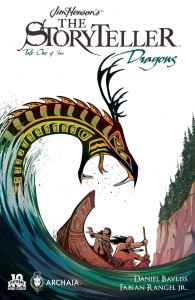 Albuquerque; Colors: Marissa Louise
Albuquerque; Colors: Marissa Louise
Black Jack Ketchum #1 (of 4) — Writer: Brian Schirmer; Art/Colors: Claudia Balboni
A bunch of small-press debuts; Carver is Will Eisnerish 40s-style pulp with the rare ability to get better the more  you look at it, has a three-page back-up story by Paul Pope, and is worth buying. Seduction of the Innocent is EC-style true-crime gangster noir set in early-’50s San Francisco, one of those books where you shouldn’t get too attached to any of the characters, because they’re all going to meet bloodily-violent ends. Jim Henson’s Storyteller: Dragons, is, unsurprisingly, stories about dragons: in this issue, that involves a Pacific Northwest Native American myth; it’s worth it for the way Bayless just
you look at it, has a three-page back-up story by Paul Pope, and is worth buying. Seduction of the Innocent is EC-style true-crime gangster noir set in early-’50s San Francisco, one of those books where you shouldn’t get too attached to any of the characters, because they’re all going to meet bloodily-violent ends. Jim Henson’s Storyteller: Dragons, is, unsurprisingly, stories about dragons: in this issue, that involves a Pacific Northwest Native American myth; it’s worth it for the way Bayless just  absolutely nails every panel with the horned sea serpent, gaudy colors and all. Replica is future-cop sf; its matter-of-fact alien setting and sly humor remind me of Keith Laumer. Mystery Girl is more modern fantasy than sf, about a London “street detective” who, if she thinks about it, knows the answer to every mystery (except the one of how she knows this
absolutely nails every panel with the horned sea serpent, gaudy colors and all. Replica is future-cop sf; its matter-of-fact alien setting and sly humor remind me of Keith Laumer. Mystery Girl is more modern fantasy than sf, about a London “street detective” who, if she thinks about it, knows the answer to every mystery (except the one of how she knows this 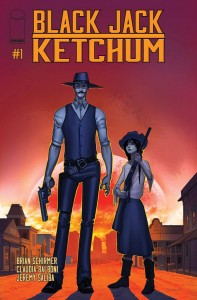 stuff). For some reason the art made me think of William Messner-Loeb, maybe because it seems like the kind of cheerfully-scruffy, London-based tale that early-’90s Vertigo would have published. Black Jack Ketchum is an occult Western, set on an alternate Earth where magic works, and its four issues seem just about the right length for its creators to have fun and make their point; it’s helped by the Balboni art and coloring, with a wonderful splash page of a demon train and a full-page promo cover of the next issue making the sale.
stuff). For some reason the art made me think of William Messner-Loeb, maybe because it seems like the kind of cheerfully-scruffy, London-based tale that early-’90s Vertigo would have published. Black Jack Ketchum is an occult Western, set on an alternate Earth where magic works, and its four issues seem just about the right length for its creators to have fun and make their point; it’s helped by the Balboni art and coloring, with a wonderful splash page of a demon train and a full-page promo cover of the next issue making the sale.
 James Bond: VARGR #2 — Writer: Warren Ellis; Art: Jason Masters; Colors: Guy Major
James Bond: VARGR #2 — Writer: Warren Ellis; Art: Jason Masters; Colors: Guy Major
Citizen Jack #2 — Writer: Sam Humphries; Art: Tommy Patterson; Colors: Jon Alderink
Paper Girls #3 — Writer: Brian K. Vaughan; Art: Cliff 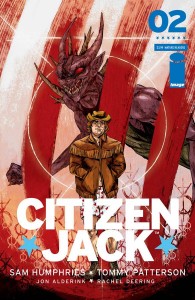 Chiang; Colors: Matt Wilson
Chiang; Colors: Matt Wilson
Plutona #3 — Writer: Jeff Lemire; Art: Emi Lenox; Colors: Jordie Bellaire
Dark Corridor #5 — Creator: Rich Tommaso
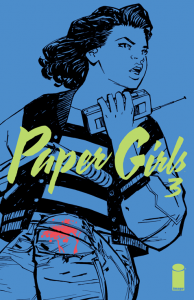 Rocket Girl #7 — Writer: Brandon Montclare; Art/Colors: Amy Reeder
Rocket Girl #7 — Writer: Brandon Montclare; Art/Colors: Amy Reeder
Everything else: James Bond is Warren Ellis covering Bond on a mission, getting seduced by a tech-enhanced assassin, surviving a car wreck, touring a very British- foreign-office spy headquarters, confronting the villain in his lair (he’s making designer drugs with grotesque consequences for London’s youth): the usual, that is, and very smoothly done. Citizen Jack is about a good-ol’-boy small-business owner who makes a deal with the devil to get elected President; his attempts to stand out in a crowded primary field give it a particularly-current satirical buzz. The last four are all keepers: Paper Girls
foreign-office spy headquarters, confronting the villain in his lair (he’s making designer drugs with grotesque consequences for London’s youth): the usual, that is, and very smoothly done. Citizen Jack is about a good-ol’-boy small-business owner who makes a deal with the devil to get elected President; his attempts to stand out in a crowded primary field give it a particularly-current satirical buzz. The last four are all keepers: Paper Girls  continues its very fast-paced suburban-adventure sf tale, and benefits from Chiang’s breezy simplicity of style and willingness to tackle any damn thing Vaughan asks him to draw and make it look good. Plutona is Jeff Lemire’s story of a bunch of kids who find a dead superheroine in the woods, a weird hybrid of Archie, Peanuts, The Goonies, and Stand By Me with brightly-
continues its very fast-paced suburban-adventure sf tale, and benefits from Chiang’s breezy simplicity of style and willingness to tackle any damn thing Vaughan asks him to draw and make it look good. Plutona is Jeff Lemire’s story of a bunch of kids who find a dead superheroine in the woods, a weird hybrid of Archie, Peanuts, The Goonies, and Stand By Me with brightly-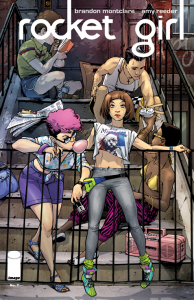 colored, open mangaesque art. The key words for Dark Corridor are “pulpish,” “noir,” “undergroundish” and “good”; Tommaso’s developing a classical-cartoonish thin-lined simplicity that looks very sharp. Rocket Girl is its opposite, with an optimistic sf-adventure young heroine and the always-welcome chance of seeing Amy Reeder art (she and Montclare teamed up to write last week’s Moon Girl and Devil Dinosaur, which has a similar geeky charm): looking at that cover makes a great way to end this list.
colored, open mangaesque art. The key words for Dark Corridor are “pulpish,” “noir,” “undergroundish” and “good”; Tommaso’s developing a classical-cartoonish thin-lined simplicity that looks very sharp. Rocket Girl is its opposite, with an optimistic sf-adventure young heroine and the always-welcome chance of seeing Amy Reeder art (she and Montclare teamed up to write last week’s Moon Girl and Devil Dinosaur, which has a similar geeky charm): looking at that cover makes a great way to end this list.



